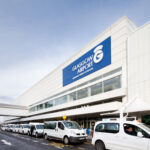
Meet the academic predicting the future of autonomous aircraft

“Every time I carry out research into future urban air mobility systems, I am one step closer to my dream,” remarks Dr Ye Yuan, an aerospace engineering lecturer from Swansea University. He is convinced that one day electric vertical take-off and landing (eVTOL) aircraft will become a convenient and environmentally sustainable means of travel for people in and between urban centres.
Ye Yuan grew up close to a helicopter airbase in the Chinese city of Jinan, which has a population similar to that of London, and would often watch helicopters take off and land. “I always thought helicopters were cool and looked great, and I wanted to fly one.
“But when I was 16 or 17 years old I learnt that issues with my right ear meant I could never become a pilot, as you need to have hearing in both ears to pass the training and get your licence. So I thought, ok, what if the helicopter could fly all by itself?”
After studying in China, he moved to the UK and became a post-doctoral researcher at Glasgow University specialising in aerospace engineering. Eighteen months ago he transferred across to Swansea University, while at around the same time securing £30,000 of funding for his work from the Department for Transport’s Transport Research & Innovation Grant programme delivered in partnership with Connected Places Catapult.
The money helped to support his ongoing research into autonomous air mobility systems, and the Catapult also helped Ye Yuan to foster new connections.
“Securing the funding was very exciting for me and allowed me to continue my work. It was also proof that this area is worth investigating and that people want to see more. nnI am also grateful to the Catapult for introducing me to Professor Weisi Guo from Cranfield University, who is conducting research into artificial intelligence, and for putting me in touch with an aerospace company keen to share ideas.”Dr Ye Yuan
Ye Yuan is now developing a proposal for a Knowledge Transfer Partnership – a programme which aims to transfer insights from research organisations into industry to develop innovative new products and services – and is looking to enrol on a Future Leaders Fellowship programme through UK Research & Innovation, with support from the Catapult.
Outlining his future aircraft vision
Ye Yuan hopes to one day see large numbers of unmanned aviation vehicles or helicopters criss-cross the skies. “It would be entirely reasonable to expect that they replace some car journeys and help to reduce traffic jams on the roads,” he says. “They will also complete journeys more quickly and help towards meeting our net zero commitment.”
A key objective of his current research is to identify ways of ensuring that unmanned aircraft avoid collisions. He is also planning to allow members of the public into a flight similar at Swansea University to demonstrate how the technology would work and experience such a flight.
“Some people think that unmanned aircraft only belong in science fiction movies, but I predict they will be seen in 30 years’ time.”
Ye Yuan points out that removing the pilot from a helicopter or small aeroplane would significantly reduce the cost of private hired transport services to the public. That could make them more affordable, he says, compared to conventional taxis for trips across large and congested cities.
His expects the longest autonomous aircraft flights to be no more than 200 miles, allowing travel between cities, but more typically would be used for journeys between 15 and 35 miles.
Ye Yuan’s research falls broadly into three categories: the autonomous control of an unmanned air vehicle, aerodynamics and the need to reduce vibration, and the development of a new air traffic management system.
“Airports today feature a control tower where people are in control, but in the future their operation could be totally autonomous, with a thousand small aircraft flying simultaneously.”
He expects that passengers will arrange flights using a smartphone, in a similar way to how many city dwellers book minicabs. Systems currently being explored would allow aircraft to return swiftly to one of a series of vertical take off and landing sites in case of emergency.

Speaking up for academic researchers
Ye Yuan recognises that some people may ask why an academic researcher from a university should take a lead in developing the use case for new transport technologies, rather than leaving it to an industrial company to carry out. “The problem is that companies want to make money quickly and see a profit almost immediately, whereas a researcher can be focused on a piece of work for ten or more years.
“I’m very close to providing something that should help industrial companies in this area and like many researchers I meet in the UK, I’m willing to make that available to benefit not only companies themselves but society.”
For other academics looking to explore a specialist area of research, he offers this advice: “Do something you like; not because you think it will lead to financial reward.”
See details of Ye Yuan’s research and published work.
To be alerted about future opportunities at Connected Places Catapult, join our Academic Network.





